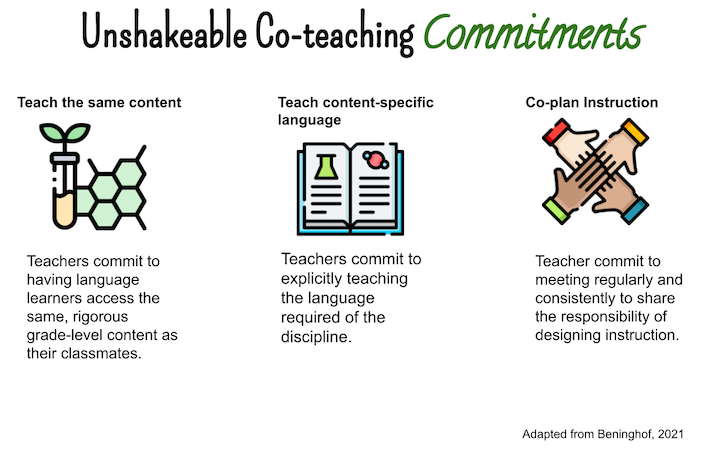Coteacher Commitments That Build Collaboration
A MiddleWeb Blog
 At the beginning of the year, many of us co-write expectations with our students. These are agreements that we all promise to adhere to so that everyone starts strong.
At the beginning of the year, many of us co-write expectations with our students. These are agreements that we all promise to adhere to so that everyone starts strong.
We can transfer this helpful practice into our co-teaching relationships as well.
Anne Beninghof, author of Co-Teaching That Works: Structures and Strategies for Maximizing Student Learning (2020), shares three essential commitments of co-teaching that can ground our collaborative work.
1. Teach the same content
Commit to teaching the same content when co-teaching. This means that language learners learn the same grade-level content as the rest of the class. Language learners who are in 6th grade cannot be expected to learn 3rd grade curriculum. This demotion would widen the achievement gap and produce an inequitable learning experience.
To teach the same content:
► Language learners engage in the same tasks but with appropriate scaffolds provided through sheltered instruction (Nora & Echevarria, 2016).
► Language specialists access the same content-specific materials (videos, articles, manipulatives, resources, etc.).
► Language learners must be in the same class along with fellow classmates.
2. Teach content-specific language
Each discipline follows different language rules and conventions. It’s imperative that content and language teachers pair up to explicitly teach content-specific language. Otherwise, language learners will struggle to access content-based videos and articles; not be able to engage in content-specific activities (e.g., case studies, experiments, demonstrations, etc.), and not develop content-specific writing skills.
To teach discipline-specific language, teachers must:
► Identify key content-specific vocabulary words.
► Highlight how content-specific vocabulary is used in a sentence (Gottlieb & Ernst-Slavit, 2014).
► Model how content-specific sentences are organized (Staehr Fenner & Snyder, 2017).
3. Co-plan instruction
I like to share with teachers that the fruit of co-teaching is rooted in intentional co-planning. Without co-planning, there is no co-teaching. Instead, the ML teacher is relegated to in-class support. Students can certainly benefit from the specialist supporting the learning, but in-class support is less effective than co-teaching that was co-planned.
A commitment to co-planning would entail:
► Having a consistent co-planning time scheduled into both educators’ timetables;
► The language specialist having access to the grade-level curriculum guide and materials;
► Designing high-yield items such as long-term summative projects, assessments, rubrics, and unit plans;
► Planning that identifies the content, process, and product (Tomlinson, 2014);
► Agreeing on how and what to scaffold and differentiate to make content comprehensible and output possible (Ferlazzo & Hull Sypnieski, 2018);
► Identifying who receives the scaffolds and when to receive the differentiated instruction;
► Selecting the co-teaching model or arrangement that works best for a particular lesson (Honigsfeld & Dove, 2019).
Don’t default to any role less than co-teacher
I wish I had established these commitments when I first started co-teaching. Because I began without these, I defaulted to becoming an instructional aide for many years. While I did help many students as an aide, I also learned that language specialists could be so much more.
Try starting your first co-planning meeting of the year by introducing these three commitments with your co-teacher. This opening will help hone and shape the intention of the collaboration, starting everyone off with clear common goals in place.
Which of these commitments will you recommit to in your collaborative practice? Which commitment is most present in your relationships?
Listen to Tan Huynh’s podcast conversation with Anne Beninghof, an expert in special education who shares how we can make co-teaching work.
Resources
Beninghof, A. M. (2020). Co-teaching that works: Structures and strategies for maximizing student learning (2nd edition). Jossey-Bass.
Ferlazzo, L. & Hull Sypnieski, K. (2018). The ELL teacher’s toolbox: Hundreds of practical ideas to support your students. John Wiley & Sons.
Gottlieb, M. & Ernst-Slavit, G. (2014). Academic language in diverse classrooms: Definitions and contexts. Corwin.
Honigsfeld, A. & Dove, M. G. (2019). Collaborating for English learners: A foundational guide to integrated practices (2nd edition). Corwin.
Nora, J. & Echevarria, J. (2016). No more low expectations for English learners (Not this but that). Heinemann.



































